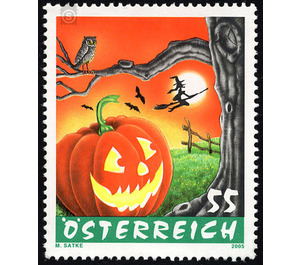Halloween - Austria / II. Republic of Austria 2005 - 55 Euro Cent
Theme: Calender
| Country | Austria / II. Republic of Austria |
| Issue Date | 2005 |
| Face Value | 55.00 |
| Edition Issued | 1,000,000 |
| Printing Type | Photogravure |
| Stamp Type | Commemorative |
| Item Type | Stamp |
| Chronological Issue Number | 1888 |
| Chronological Chapter | OOS-OE2 |
| SID | 199531 |
| In 50 Wishlists | |
With the beginning of autumn at the equinox, the nights are slowly getting longer again, the leaves begin to change color, it gets cooler and darker. Since time immemorial much customs are associated with this season. The summer has brought rich harvest, now the cattle are driven away by the pastures and the main work of the peasants is done. The people thank for the rich harvest in the form of festivals of all kinds. Many of these customs contain the last remnants of pagan cultural heritage. In recent years, a custom has come from America to Europe that is barely known to be truly an ancient European Celtic custom: Halloween. This Celtic festival was mainly known in the British Isles, in Ireland and later also in northern France. By the 31st of October the year ended according to Celtic-Druidic faith. Before the beginning of the New Year, November 1, was the night called "Samhain," in which the Celts crossed the line between death and life, and feared that the spirits could seize their bodies. The Druids tried to protect the living from the dead by moving from house to house and, in exchange for sacrificial offerings, handing over hollowed-out, beetroot-like turnips to the dwellers as a deterrent to the evil spirits. In Ireland, there was also the habit of people extinguishing their hearths that night, disguising themselves as frighteningly as possible, and making noisy noises to deter the ghosts. Despite the Christianization, people were not deterred by this custom and so it was simply made a church holiday. In 837, Pope Gregory IV consecrated a chapel to all the saints in the Basilica of St. Peter and set "All Saints" on the 1st of November. The name Halloween derives from the eve of All Saints Day (All hallows eve). Probably Halloween with Irish emigrants came to America around 1840 and presumably in America, the inconspicuous hollowed turnip turned into the larger pumpkin. The "trick or treating", where children go from house to house begging for sweets, dates back to the 9th century, when young Christians wandered from door to door, begging for "soul cakes", square breads with redcurrants, for them then prayed for the donors and the deceased. They did not get any loaves (treat) then they cursed (trick) them the house. At the end of the 20th century, the custom came back. Especially for the joy of all children, Halloween is becoming more and more prevalent in Europe.


